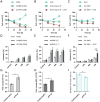Cellular sensitivity to UV-irradiation is mediated by RNA polymerase I transcription
- PMID: 28636660
- PMCID: PMC5479586
- DOI: 10.1371/journal.pone.0179843
Cellular sensitivity to UV-irradiation is mediated by RNA polymerase I transcription
Abstract
The nucleolus has long been considered to be a pure ribosome factory. However, over the last two decades it became clear that the nucleolus is involved in numerous other functions besides ribosome biogenesis. Our experiments indicate that the activity of RNA polymerase I (Pol I) transcription monitors the integrity of the DNA and influences the response to nucleolar stress as well as the rate of survival. Cells with a repressed ribosomal DNA (rDNA) transcription activity showed an increased and prolonged p53 stabilisation after UVC-irradiation. Furthermore, p53 stabilisation after inhibition and especially after UVC-irradiation might be due to abrogation of the HDM2-p53 degradation pathway by ribosomal proteins (RPs). Apoptosis mediated by highly activated p53 is a typical hallmark of Cockayne syndrome cells and transcriptional abnormalities and the following activation of the RP-HDM2-p53 pathway would be a possible explanation.
Conflict of interest statement
Figures



References
-
- Laugel V (2013) Cockayne syndrome: the expanding clinical and mutational spectrum. Mech Ageing Dev 134: 161–170. doi: 10.1016/j.mad.2013.02.006 - DOI - PubMed
-
- Bradsher J, Auriol J, Proietti de Santis L, Iben S, Vonesch JL, Grummt I et al. (2002) CSB is a component of RNA pol I transcription. Mol Cell 10: 819–829. - PubMed
-
- Iben S, Tschochner H, Bier M, Hoogstraten D, Hozak P, Egly JM et al. (2002) TFIIH plays an essential role in RNA polymerase I transcription. Cell 109: 297–306. - PubMed
-
- Lebedev A, Scharffetter-Kochanek K, Iben S (2008) Truncated Cockayne syndrome B protein represses elongation by RNA polymerase I. J Mol Biol 382: 266–274. doi: 10.1016/j.jmb.2008.07.018 - DOI - PubMed
MeSH terms
Substances
LinkOut - more resources
Full Text Sources
Other Literature Sources
Research Materials
Miscellaneous

